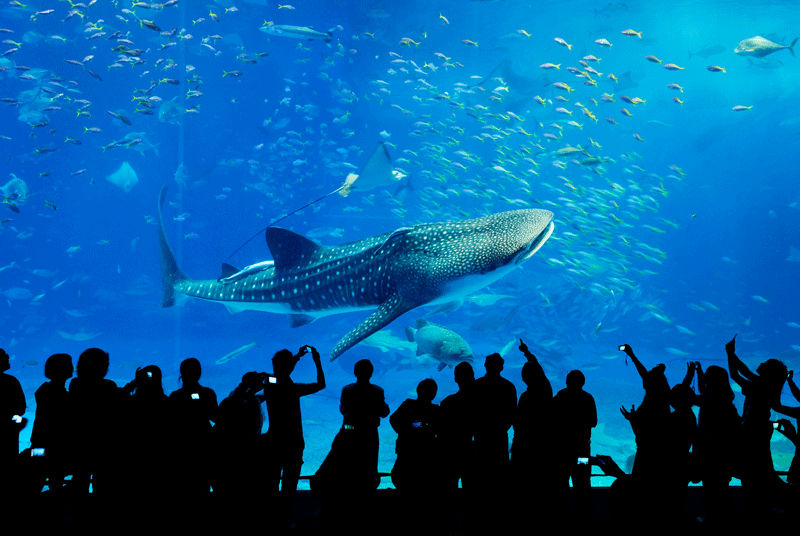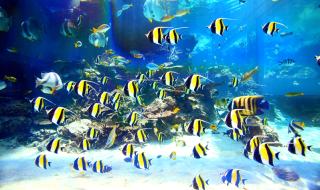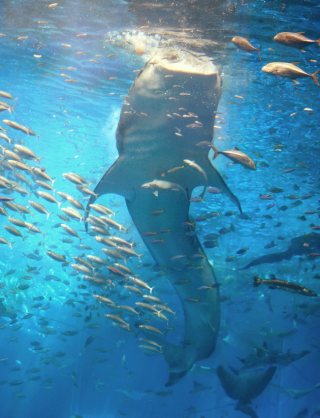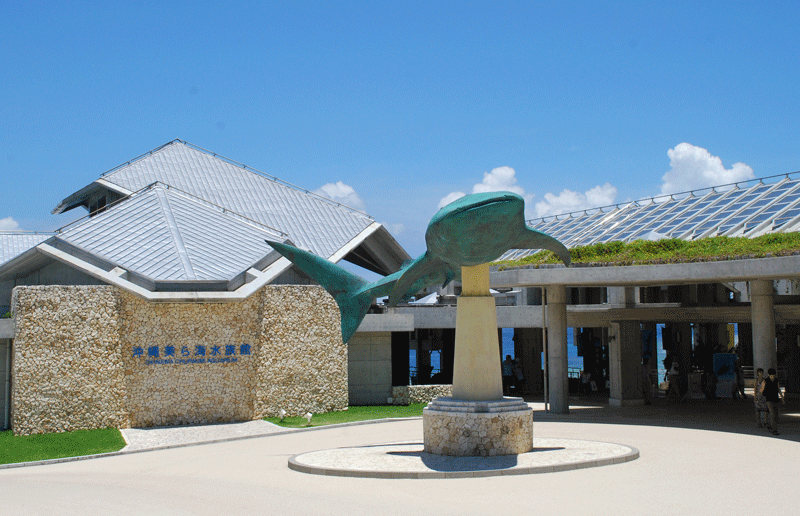Ocean Expo Park is not just home to one of the largest aquariums in the world – it’s also a place where you can see more of Okinawa than you’d expect.
By Andy Gayler
So you go to Okinawa to see the sea. It’s blue and beautiful. It’s the “beautiful sea,” you see. The Okinawans themselves even have a special word for it: churaumi. Chura for beautiful in the local language, and umi, well, for sea. And what a great word that would be if, for example, you opened a really, really big place to celebrate this awesome pool of salty water and those amazing creatures living in it. You could call it Okinawa Churaumi Aquarium.
Well, apparently, some other people thought so too and did just. The name was selected back in 2002, after 13,897 names were suggested in a nationwide competition to name the site that is now arguably Okinawa’s most impressive tourist attraction and unarguably one of the biggest aquariums in the world. Yes, the world. This tiny little island, 1,500 km south of Tokyo and only 112 km from north to south, running along the line where the Pacific Ocean meets the East China Sea, is home to a huge and incredibly successful representation of marine life. This means that, even if you live in Tokyo, you can visit an extraordinary – and in some cases unique – collection of undersea life, all on a weekend trip to the island prefecture.
The pretty coral beds that have been grown from tiny translucent polyps to colorful colonies are the first thing visitors will be drawn to on entering the main building and are a good indication of what lives in the shallower waters surrounding the island. And it’s the logical place to start as the coral reefs are the essential factor for sustaining the variety of sea life up the entire food chain in these and any tropical waters (in fact, as much as one quarter of all sea life is estimated to be dependent on coral reefs for shelter and food). And it’s this food chain that the aquarium will take you through: from coral to crustaceans, including the Japanese spider crab (the largest crab in the world), small fish to big fish and then onto the largest fish of all: the whale shark. The main building is designed to take you on a tour from the beach to the deep sea, where darker habitats reveal sea life rarely seen by humans, and replicating the actual sea around Okinawa which drops to depths of 700 meters on either side.
Although no one has dug down 700 meters to build such a large tank, the one they do have for this demonstration of the deep is extremely large. Measuring 8.2 meters high, 22.5 meters wide, and made with 60cm thick acrylic windows, the Kuroshio (“Black Currents”) Sea Tank holds 7,500 cubic meters of water. The main tank is bursting with about 70 different species, including hypnotic manta rays “flying” around, but the main attractions are the three whale sharks. These 8.5-meter-long fish (although they can grow to be longer than 12 meters) can be viewed from above, at the observation deck, or through the huge window of the Aqua Room. At four different times during the day, special “Kuroshio” programs are held that provide more information about the massive tank and its varied inhabitants. Visitors can see the whale sharks take two afternoon meals at 3 pm and 5 pm. Equally impressive are the feedings of the graceful and enchanting manta rays, who eat a few minutes after the whale sharks do.
Misunderstood Hunters
In another large – but not so intimidating – tank reside some not so large but definitely intimidating fishes. In fact, though, one of the main reasons that the denizens of this 800-cubic-meter tank are viewed with fear is that they are poorly understood. Of course, there is something in the appearance of these long-bodied, sharp-toothed, large-mouthed sharks, including bulls, tigers and sicklefin lemon sharks, that will inspire you with a sense of awe – and maybe just a touch of the willies. You can watch these tough-guy predators as they make their way around their tank, and occasionally catch a feeding session. However, these apex predators are actually quite sensitive and not nearly as ravenous as the movies would have us believe. A visit to the interactive Shark Research Lab where the “Dangerous Sharks” tank will fill you in on many details of these fascinating creatures’ lives, and it’s a place where the world’s first lemon shark was successfully born in captivity.
But it’s not all about these large tanks, impressive as they are. Or even the equally captivating smaller tanks teeming with all kinds of mysterious aquatic fauna, sporting curious body shapes and exotic-sounding names and hailing from environments as diverse as shallow coral reef areas and depths more profound than 200 meters. In fact, the aquarium itself is only one small part, although still the main attraction, of the very large Ocean Expo Park that sits snugly along the picturesque coast of Motobu in the north of the island. Outside the main building there’s more than enough to fill a day, or possibly two. In the park grounds there’s a turtle pool, with a breeding program for a couple of endangered species; another watery enclosure with zen-like, peaceful manatees from Mexico; and then you’ve got the Oki-chan Theater, which features a free dolphin and false killer whale show, where the cetaceans show off their leaping abilities with the East China Sea as a backdrop. It’s not hard to be impressed.
Beyond the Waters
Ocean Expo Park started life as a legacy of the Okinawa Ocean Expo ’75, held, in part, to commemorate the USA’s handing of Okinawa back to Japan in 1972, and has since become a beacon of tourism possibilities for the Ryukyu archipelago. It’s a great example of what the island could do if it just had more space, and more locations like this established for tourists and locals alike. Okinawa is already popular as a tourist destination, mostly with Japanese and Chinese visitors, but more endeavors like these could very well raise the prefecture’s profile and become a magnet for tourism in the Pacific.
In the areas of Ocean Expo Park that aren’t about the sea and sea dwellers there are sites that get less of a fanfare. This does them a disservice because the Tropical Dream Center alone is worth a few hours for a quiet stroll of any cerebral tourist’s time. It’s a tranquil site blooming with subtropical plants in gardens and greenhouses with a lotus pond, hanging plants, a spiraling brick tower and other flights of architectural fancy, as well as a whole lot of orchids.
In a similar vein, the Tropical and Subtropical Arboretum is the place to learn about Okinawa’s tree life; the Oceanic Culture Museum and the Planetarium offer an insight into the people and the skies; and the traditional Okinawan village gives you a glimpse into the homes of old. So, if you only have one place you can visit in Okinawa during a quick getaway from Tokyo, Ocean Expo Park might just have almost everything you need to become a better-informed visitor.
For more information about Okinawa Churaumi Aquarium please visit the official website: oki-churaumi.jp/en
Photos courtesy of Ocean Expo Park/Okinawa Churaumi Aquarium
Sponsored Post
Updated On July 18, 2017











